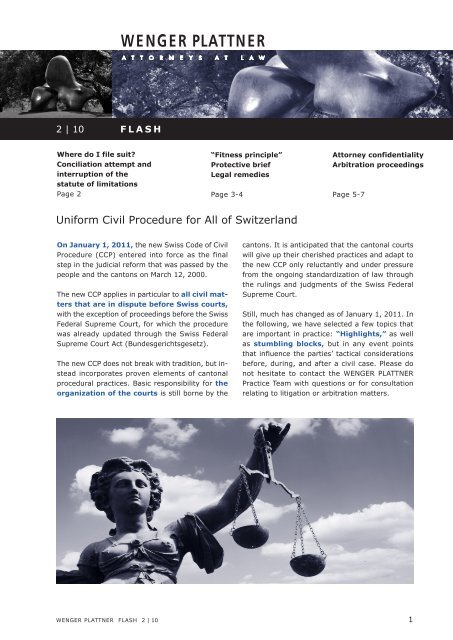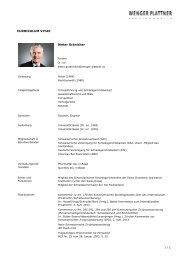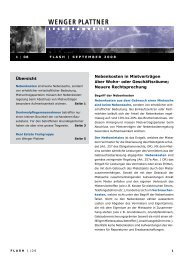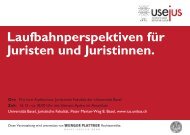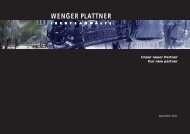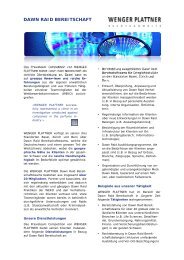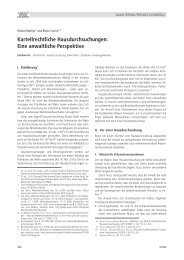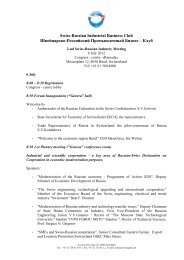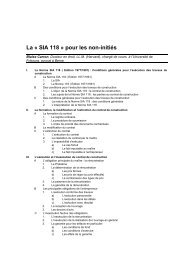New Swiss Code of Civil Procedure - Wenger Plattner
New Swiss Code of Civil Procedure - Wenger Plattner
New Swiss Code of Civil Procedure - Wenger Plattner
Create successful ePaper yourself
Turn your PDF publications into a flip-book with our unique Google optimized e-Paper software.
2 | 10 F L A S H<br />
Where do I file suit?<br />
Conciliation attempt and<br />
interruption <strong>of</strong> the<br />
statute <strong>of</strong> limitations<br />
Page 2<br />
“Fitness principle”<br />
Protective brief<br />
Legal remedies<br />
Page 3-4<br />
Attorney confidentiality<br />
Arbitration proceedings<br />
Page 5-7<br />
Uniform <strong>Civil</strong> <strong>Procedure</strong> for All <strong>of</strong> Switzerland<br />
On January 1, 2011, the new <strong>Swiss</strong> <strong>Code</strong> <strong>of</strong> <strong>Civil</strong><br />
<strong>Procedure</strong> (CCP) entered into force as the final<br />
step in the judicial reform that was passed by the<br />
people and the cantons on March 12, 2000.<br />
The new CCP applies in particular to all civil matters<br />
that are in dispute before <strong>Swiss</strong> courts,<br />
with the exception <strong>of</strong> proceedings before the <strong>Swiss</strong><br />
Federal Supreme Court, for which the procedure<br />
was already updated through the <strong>Swiss</strong> Federal<br />
Supreme Court Act (Bundesgerichtsgesetz).<br />
The new CCP does not break with tradition, but instead<br />
incorporates proven elements <strong>of</strong> cantonal<br />
procedural practices. Basic responsibility for the<br />
organization <strong>of</strong> the courts is still borne by the<br />
cantons. It is anticipated that the cantonal courts<br />
will give up their cherished practices and adapt to<br />
the new CCP only reluctantly and under pressure<br />
from the ongoing standardization <strong>of</strong> law through<br />
the rulings and judgments <strong>of</strong> the <strong>Swiss</strong> Federal<br />
Supreme Court.<br />
Still, much has changed as <strong>of</strong> January 1, 2011. In<br />
the following, we have selected a few topics that<br />
are important in practice: “Highlights,” as well<br />
as stumbling blocks, but in any event points<br />
that influence the parties’ tactical considerations<br />
before, during, and after a civil case. Please do<br />
not hesitate to contact the WENGER PLATTNER<br />
Practice Team with questions or for consultation<br />
relating to litigation or arbitration matters.<br />
WENGER PLATTNER FLASH 2 | 10 1
Where do I file suit?<br />
Jurisdiction ratione loci<br />
The new CCP largely incorporates the regulation<br />
on jurisdiction ratione loci as standardized by<br />
the <strong>Swiss</strong> <strong>Civil</strong> Jurisdiction Act. But it also introduces<br />
innovations that are important in practice:<br />
The obligee can now choose whether to sue the<br />
obligor at his domicile/seat or at the place <strong>of</strong> performance<br />
<strong>of</strong> the characteristic service. The<br />
place <strong>of</strong> performance is the place where the service<br />
that characterizes the contract in question is<br />
to be carried out. The characteristic service is the<br />
action that comprises the typical attribute <strong>of</strong> the<br />
respective contract type: performance by the<br />
seller in the case <strong>of</strong> a sales contract, work performance<br />
in the case <strong>of</strong> a service contract, etc. The<br />
place at which this performance is to be done is<br />
stipulated by contract, or alternatively by law.<br />
In practice, agreements on jurisdiction are very<br />
important: An agreement on jurisdiction is an<br />
agreement whereby the parties specify – usually in<br />
advance – which court is to have jurisdiction over<br />
their dispute. As in the past, the stipulated court<br />
and the choice <strong>of</strong> the law that is to govern the<br />
agreement must be identified precisely. What is<br />
new is that the stipulated court can no longer deny<br />
its jurisdiction, but must accept the case. An<br />
agreement on jurisdiction is valid if it is provable<br />
by text. Thus, for example, it is possible to enter<br />
into an agreement on jurisdiction via a website if<br />
the customer expressly consents (“tick the box”).<br />
Conciliation attempt and<br />
interruption <strong>of</strong> the statute <strong>of</strong><br />
limitations<br />
The rule under the new CCP is: “first conciliate,<br />
then adjudicate.” In order to reduce the courts’<br />
workload and facilitate the parties’ first step in the<br />
legal arena, proceedings must, as a matter <strong>of</strong> principle,<br />
be preceded by an attempt at conciliation or<br />
mediation. This has consequences for the interruption<br />
<strong>of</strong> the statute <strong>of</strong> limitations:<br />
Requests for conciliation or mediation interrupt<br />
the statute <strong>of</strong> limitations, although this holds<br />
true <strong>of</strong> the latter only if the mediation is requested<br />
from the conciliation authorities.<br />
With disputes for which only one cantonal authority<br />
has jurisdiction (e.g., the commercial court),<br />
there is no possibility <strong>of</strong> a conciliation attempt.<br />
This means that interrupting the statute <strong>of</strong> limitations<br />
requires the filing <strong>of</strong> a (complex) suit instead<br />
<strong>of</strong> a (simple) conciliation request.<br />
If a claim is on the verge <strong>of</strong> becoming statutebarred,<br />
the competent court must be identified<br />
quickly, accompanied by a quick assessment as<br />
to whether an attempt at conciliation is required.<br />
Otherwise it is a good idea to begin drafting<br />
the suit at an early stage, especially if the<br />
statute <strong>of</strong> limitations cannot be interrupted<br />
through debt enforcement for lack <strong>of</strong> a place <strong>of</strong><br />
debt enforcement in Switzerland.<br />
In the absence <strong>of</strong> a provision to the contrary in<br />
the agreement on jurisdiction, an action may<br />
be brought at the agreed place <strong>of</strong> jurisdiction<br />
only. If the plaintiff is to be given a choice between<br />
the ordinary court and the agreed court,<br />
this must be expressly stated in the stipulation<br />
<strong>of</strong> venue.<br />
However, the new CCP has also introduced a<br />
significant relief in the area <strong>of</strong> statute <strong>of</strong> limitations:<br />
Under the old law, a claim could become<br />
statute-barred “under the judge’s hand” (especially<br />
with short – e.g., one-year – limitation<br />
periods). The limitation period could be restarted<br />
only through judicial action by the parties or else<br />
through an order or decision by the court. Now,<br />
the limitation period that has been interrupted by<br />
a conciliation request, the filing <strong>of</strong> suit, or the<br />
raising <strong>of</strong> a defense begins running again only<br />
after the litigation before the competent instance<br />
has been concluded.<br />
2 WENGER PLATTNER FLASH 2 | 10
<strong>New</strong> to the procedure:<br />
The “fitness principle”<br />
A quick perusal <strong>of</strong> the new CCP makes it immediately<br />
clear that “harmonizing” 26 codes <strong>of</strong> procedure<br />
necessitated a typically <strong>Swiss</strong> compromise.<br />
Nevertheless, it is evident from the wording <strong>of</strong> the<br />
law, the explanatory report <strong>of</strong> the Federal Council,<br />
and the genesis <strong>of</strong> the changes that the objective<br />
pursued by lawmakers was to make the procedure<br />
flexible, quick, simple, lay-friendly as well as<br />
cost effective. In reference to other process principles<br />
we contend, therefore, that the new <strong>Code</strong><br />
<strong>of</strong> <strong>Civil</strong> <strong>Procedure</strong> is governed by the “fitness principle”.<br />
Actually, the court possesses a large degree <strong>of</strong><br />
flexibility when it comes to how the proceeding is<br />
to be structured: Depending on the amount in dispute<br />
and the complexity <strong>of</strong> the case, a simpler or<br />
a more refined proceeding can be ordered. As a<br />
matter <strong>of</strong> principle, a civil case begins with a written<br />
statement <strong>of</strong> claim followed by a written statement<br />
<strong>of</strong> defense. If less than CHF 30,000 is<br />
in dispute, parties may present their respective<br />
positions orally. The case continues with oral<br />
arguments at the beginning <strong>of</strong> the hearing phase.<br />
However, the court can also order a second<br />
exchange <strong>of</strong> written submissions and, moreover,<br />
summon the parties to a preparatory hearing (Instruktionsverhandlung)<br />
prior to the main hearing.<br />
This flexibility has advantages and drawbacks:<br />
Because the court has considerable leeway in how<br />
the proceeding is to be conducted, for example,<br />
the parties cannot know at the beginning <strong>of</strong> the<br />
proceeding what the deadline is for their presentation<br />
<strong>of</strong> allegations and facts and for submission<br />
<strong>of</strong> the corresponding evidence. In particular, it is<br />
no longer possible – as the former law allowed in<br />
some cantons – to wait until the court requests<br />
evidence before submitting it.<br />
Parties are advised to present the entirety <strong>of</strong><br />
their allegations in their very first submission<br />
and to submit all available documents at the<br />
same time.<br />
Turning away from a rigid solution for all cases<br />
should result in an overall improvement in efficiency,<br />
and thus lead to the swifter handling <strong>of</strong><br />
cases. It remains to be seen how the individual<br />
courts are going to implement this flexibility. As a<br />
general trend, however, it can be assumed that the<br />
courts will try to “accommodate” their previous<br />
procedure under the new CCP so that they are forced<br />
to change their practices as little as possible.<br />
Precautionary measure against<br />
precautionary measures:<br />
The protective brief<br />
In the area <strong>of</strong> precautionary legal protection, the<br />
new CCP does not introduce substantive innovations,<br />
but is instead heavily founded on the existing<br />
law. One new element, however, is the<br />
“protective brief” (Schutzschrift), which has not<br />
been widely used in the past and was not addressed<br />
in the cantonal codes <strong>of</strong> civil procedure.<br />
The protective brief is a preventive means <strong>of</strong><br />
defense against an expected petition for the<br />
issuance <strong>of</strong> an interim injunction ex parte, an<br />
attachment under the Debt Enforcement and<br />
Bankruptcy Act, or another interim measure concerning<br />
which the respondent is for once not heard<br />
in advance. This is conceivable if the petitioner can<br />
credibly rely on particular urgency. The protective<br />
brief gives the respondent a means for presenting<br />
his position in advance all the same.<br />
The protective brief reduces the risk that an<br />
The protective brief reduces the risk that an interim<br />
injunction will be approved with undue haste.<br />
interim injunction will be approved with undue<br />
haste.<br />
The anticipatory brief is valid for six months from<br />
its submission; after that time, it may no longer<br />
be considered by the court. It is sent to the opposing<br />
party only if and when that party institutes a<br />
corresponding proceeding.<br />
If multiple venues are available for an interim<br />
injunction, it is recommended that the protective<br />
brief be filed with all <strong>of</strong> the courts.<br />
WENGER PLATTNER FLASH 2 | 10 3
evision (Revision), interpretation (Erläuterung)<br />
und correction (Berichtigung) play a subordinate<br />
role.<br />
Both the appeal and the request for setting-aside<br />
must be filed with the appellate instance within 30<br />
days, in writing and with arguments. The deadline<br />
may not be extended. This means that a party that<br />
has been unsuccessful before the first instance<br />
(district court, county court, municipal court, local<br />
court, cantonal court, civil court) must decide<br />
quickly whether to challenge the lower court’s decision<br />
before the higher cantonal instance.<br />
The challenge filing deadline <strong>of</strong> 30 days from<br />
the issuance <strong>of</strong> the lower court’s decision is<br />
not the only thing that must be considered: If<br />
the lower court issues its decision without<br />
giving written reasons, the defeated party must<br />
request written reasons within 10 days, barring<br />
which the law assumes that the right to<br />
challenge the decision has been waived.<br />
When a judgment goes the<br />
wrong way: Legal remedies<br />
Under the new CCP, essentially any decision<br />
handed down by a cantonal court <strong>of</strong> first instance<br />
can be challenged before a higher cantonal court<br />
(cantonal court <strong>of</strong> appeal or cantonal supreme<br />
court), after which it can go before the <strong>Swiss</strong><br />
Federal Supreme Court. An exception is made for<br />
commercial courts (<strong>of</strong> the sort that exist in the<br />
cantons <strong>of</strong> Zurich and Bern, for example) and for<br />
actions in specific areas <strong>of</strong> law (such as intellectual<br />
property law): These decisions must be<br />
appealed directly with the <strong>Swiss</strong> Federal Supreme<br />
Court.<br />
The new CCP has two principal legal remedies: the<br />
appeal (Berufung) and the request for settingaside<br />
(Beschwerde); the three further remedies <strong>of</strong><br />
The main distinction between the appeal and the<br />
request for setting-aside is that the appeal is intended<br />
for cases with an amount in dispute <strong>of</strong> at<br />
least CHF 10,000, whereas the request for<br />
setting-aside covers “smaller” cases as well as<br />
decisions concerning the enforcement <strong>of</strong> civil<br />
judgments. Decisions handed down during a firstinstance<br />
proceeding are subject to appeal if they<br />
are actually procedural or substantive interim<br />
decisions (e.g., the dismissal <strong>of</strong> a plea under the<br />
limitation <strong>of</strong> actions). In contrast, procedural orders<br />
(e.g., an order for the taking <strong>of</strong> specific evidence)<br />
are - where applicable - to be challenged<br />
through a request for setting-aside.<br />
Of cardinal practical significance is the question as<br />
to what new facts and evidence a party may still<br />
submit to the higher cantonal instance if such materials<br />
were not presented to the court <strong>of</strong> the first<br />
instance (known as the so-called “Novenrecht”).<br />
The new CCP is strict: <strong>New</strong> facts and evidence cannot<br />
be presented to the higher cantonal instance if<br />
they could have been previously introduced before<br />
the lower court through the application <strong>of</strong> reasonable<br />
care. “Forgotten in the first instance –<br />
lost and gone forever.”<br />
4 WENGER PLATTNER FLASH 2 | 10
Thus, the client and the attorney must carefully<br />
consider at the outset what facts and evidence<br />
they want to introduce to the proceeding.<br />
For successful consultation, the client should<br />
come up with all the documents that could<br />
somehow be related to the case at the very<br />
beginning <strong>of</strong> the first-instance proceeding and<br />
make those documents available to his attorney.<br />
This has now changed with art. 160 CCP, which<br />
clearly states that an attorney’s correspondence<br />
need not be surrendered in an evidentiary<br />
proceeding. Thus, the question <strong>of</strong> whether confidential<br />
correspondence is in the possession <strong>of</strong> the<br />
attorney, the client, or a third party is no longer<br />
relevant.<br />
It is true that this provision applies to only one element<br />
<strong>of</strong> civil law – albeit an important one – but<br />
nevertheless it does represent significant progress<br />
in the area <strong>of</strong> protecting the confidentiality<br />
<strong>of</strong> exchanges between client and attorney. It<br />
remains to be seen what effect it will have on other<br />
areas <strong>of</strong> law.<br />
As <strong>of</strong> today, we recommend stamping any<br />
attorney correspondence with “ATTORNEY<br />
CORRESPONDENCE - CONFIDENTIAL”.<br />
The alternative to litigation:<br />
Arbitration<br />
The “new” attorney-client<br />
privilege<br />
Attorney-client privilege is primarily covered by the<br />
<strong>Swiss</strong> Penal <strong>Code</strong>. In the past, the rather peculiar<br />
interpretation by <strong>Swiss</strong> courts relative to elsewhere<br />
in Europe meant that confidential correspondence<br />
was protected only while situated on<br />
the attorney’s premises. Once the attorney’s correspondence<br />
was received by the client, its surrender<br />
could be demanded. This limitation <strong>of</strong><br />
attorney-client privilege was disastrous with<br />
regard to risk assessments and recommendations<br />
for future action.<br />
The new <strong>Code</strong> <strong>of</strong> <strong>Civil</strong> <strong>Procedure</strong> concerns itself not<br />
only with civil litigation before state courts, but<br />
also – in a separate third section (replacing the<br />
Concordat in place until 2010) - with the procedure<br />
before private arbitral tribunals established<br />
in Switzerland between parties residing in Switzerland<br />
(known as domestic arbitration).<br />
Arbitral proceedings are different from proceedings<br />
before a state court; in particular, the parties<br />
themselves determine the composition <strong>of</strong> the<br />
arbitral tribunal (with members whom they trust)<br />
and define the procedural rules. Nevertheless,<br />
a decision by an arbitral tribunal – the so-called<br />
arbitral award (Schiedsspruch) – has the same<br />
effect as a final and enforceable decision by a state<br />
court. Another key difference is that arbitration<br />
proceedings are conducted behind closed doors;<br />
because <strong>of</strong> the confidentiality that this ensures,<br />
arbitration is <strong>of</strong>ten the preferred means <strong>of</strong> settling<br />
disputes arising from articles <strong>of</strong> association, shareholder<br />
agreements, and similar contracts.<br />
WENGER PLATTNER FLASH 2 | 10 5
Arbitration must be clearly stipulated, barring<br />
which the state courts retain jurisdiction. Use <strong>of</strong><br />
an arbitration institution’s standard arbitration<br />
clause is recommended, or else legal consultation<br />
should be obtained.<br />
The parties are not bound to the (comparatively)<br />
rigid rules <strong>of</strong> the CCP, but can instead specify on<br />
their own how the proceeding is to be structured.<br />
Parties <strong>of</strong>ten adopt the procedural rules <strong>of</strong><br />
an arbitration institution. Within the limits <strong>of</strong> mandatory<br />
procedural rights (such as equal treatment<br />
and due process) the arbitral tribunal determines<br />
the details on how to conduct the proceedings in<br />
close coordination with the parties’ wishes.<br />
Unlike a state court, the arbitral tribunal must first<br />
be constituted when a dispute has arisen and one<br />
party wishes to sue the party to the contract. To<br />
the extent that the parties encounter problems in<br />
that area, the arbitral tribunal is constituted with<br />
the help <strong>of</strong> the arbitration institutions that the parties<br />
may have designated for that purpose (for<br />
example, chambers <strong>of</strong> commerce <strong>of</strong>fer such services),<br />
or otherwise with the help <strong>of</strong> the state court<br />
as the appointing authority.<br />
The arbitral award is only subject to an action for<br />
annulment to the <strong>Swiss</strong> Federal Supreme<br />
Court. However, only in exceptional cases is the<br />
<strong>Swiss</strong> Federal Supreme Court in a position to set<br />
aside an arbitral award. In particular, the <strong>Swiss</strong><br />
Federal Supreme Court does not review as to<br />
whether the arbitral tribunal made the right decision:<br />
even an arbitral award that is erroneous is<br />
overruled only in instances when it would lead<br />
to arbitrary results. This “shortcut regarding legal<br />
remedies” guarantees a comparatively quick (final)<br />
resolution <strong>of</strong> the case in dispute.<br />
6 WENGER PLATTNER FLASH 2 | 10
Introducing the Practice Team<br />
The WENGER PLATTNER Litigation and Arbitration<br />
Practice Team relies on pr<strong>of</strong>ound know-how and<br />
many years <strong>of</strong> experience. We <strong>of</strong>fer the following<br />
services:<br />
Team <strong>of</strong> Authors<br />
Maurice Courvoisier<br />
Dr. iur., LL.M.<br />
n<br />
n<br />
<strong>Civil</strong> litigation before all <strong>Swiss</strong> courts: representation<br />
<strong>of</strong> parties involved in disputes in all areas<br />
<strong>of</strong> civil and business law.<br />
Arbitration: we act as both counsel and<br />
arbitrator in international and domestic arbitral<br />
proceedings.<br />
Viviane Gehri-<br />
Burkhardt<br />
lic. iur.<br />
n<br />
n<br />
Proceedings before <strong>Swiss</strong> administrative and<br />
criminal authorities in all areas <strong>of</strong> administrative<br />
law and selected areas <strong>of</strong> criminal law.<br />
Consulting on the resolution <strong>of</strong> disputes (e.g.,<br />
selecting foreign trial attorneys, coordinating<br />
procedures pending outside Switzerland).<br />
Karin Graf<br />
lic. iur., LL.M.<br />
The Litigation and Arbitration Practice Team is<br />
made up <strong>of</strong> the following members in particular:<br />
n<br />
n<br />
n<br />
Basel:<br />
Dr. Maurice Courvoisier<br />
Dr. Dieter Gränicher<br />
Dr. Peter Mosimann<br />
Dr. Philippe Nordmann<br />
Dr. Werner <strong>Wenger</strong><br />
Zurich:<br />
Karin Graf<br />
Dr. Peter Reetz<br />
Dr. Marc Russenberger<br />
Karl Wüthrich<br />
Bern:<br />
Viviane Gehri-Burkhardt<br />
Dr. Fritz Rothenbühler<br />
Dieter Gränicher<br />
Dr. iur.<br />
Philippe Nordmann<br />
Dr. iur., LL.M.<br />
Peter Reetz<br />
PD Dr. iur.<br />
Marc Russenberger<br />
Dr. iur.<br />
WENGER PLATTNER FLASH 2 | 10 7
WENGER PLATTNER<br />
Attorneys at law and Public Notaries<br />
Aeschenvorstadt 55<br />
CH-4010 Basel<br />
T +41 61 279 70 00<br />
F +41 61 279 70 01<br />
basel@wenger-plattner.ch<br />
WENGER PLATTNER<br />
Attorneys at law<br />
Seestrasse 39<br />
Goldbach-Center<br />
CH-8700 Küsnacht-Zürich<br />
T +41 43 222 38 00<br />
F +41 43 222 38 01<br />
zuerich@wenger-plattner.ch<br />
WENGER PLATTNER<br />
Attorneys at law<br />
Jungfraustrasse 1<br />
CH-3000 Bern 6<br />
T +41 31 357 00 00<br />
F +41 31 357 00 01<br />
bern@wenger-plattner.ch<br />
WENGER PLATTNER<br />
11, rue du Général Dufour<br />
CH-1204 Genève<br />
T +41 22 800 32 70<br />
F +41 22 800 32 71<br />
geneve@wenger-plattner.ch<br />
www.wenger-plattner.ch


